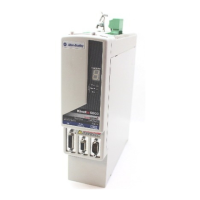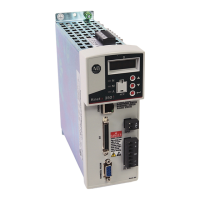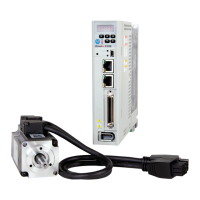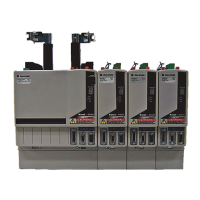70 Rockwell Automation Publication 2094-UM002G-EN-P - August 2016
Chapter 4 Connector Data and Feature Descriptions
Table 29 - Understanding Digital Input Functions
Table 30 - Digital Input Specifications
Function Description Default Behavior
IDN
Value
Enable
If the controller configuration specifies checking of the enable input, an active
state enables the power electronics to control the motor and an inactive state
prevents motion.
The drive generates an exception if the input is inactive when the controller
commands motion and has authorized checking. The drive behavior in this
situation is programmable.
The function is always inactive. If the controller instructs the drive
to monitor the Enable input, the drive issues a vendor-specific
initialization fault (Enable Input Assignment).
1
Home
An active state indicates to a homing sequence that the referencing sensor has
been seen. Typically, a transition of this signal is used to establish a reference
position for the machine axis.
The function is always inactive. If the controller instructs the drive
to perform a home procedure, the drive issues a vendor-specific
exception (Sensor Assignment).
2
Registration 1 An inactive-to-active transition (also known as a positive transition) or active-
to-inactive transition (also known as a negative transition) is used to latch
position values for use in registration moves.
The function is always inactive. If the controller instructs the drive
to perform a registration procedure, the drive issues a vendor-
specific exception (Sensor Assignment).
3
Registration 2 4
Positive
Over-travel
If the controller configuration specifies checking of the hardware over-travel
inputs, an inactive state indicates that a position limit has been exceeded in
the positive direction.
The drive generates an exception if the input is inactive when the controller
authorizes checking. The drive behavior in this situation is programmable.
The function is always inactive. If the controller instructs the drive
to monitor the hardware over-travel inputs, the drive issues a
vendor-specific initialization fault (Over-travel Input
Assignment).
5
Negative
Over-travel
If the controller configuration specifies checking of the hardware overtravel
inputs, an inactive state indicates that a position limit has been exceeded in
the negative direction.
The drive generates an exception if the input is inactive when the controller
authorizes checking. The drive behavior in this situation is programmable.
The function is always inactive. If the controller instructs the drive
to monitor the hardware over-travel inputs, the drive issues a
vendor-specific initialization fault (Over-travel Input
Assignment).
6
Regeneration
OK
An inactive state indicates that an external regenerative power supply has a
fault and a regenerative power supply exception is generated by the drive.
The function is always active. If the controller instructs the drive
that a regenerative power supply with a fault output is present,
the drive issues a vendor-specific initialization fault
(Regeneration OK Input Assignment).
7
Attribute Value
Type Active high, single-ended, current sinking
Assignable functions
Enable, Home, Positive Over-travel, Negative Over-travel,
Registration 1, Registration 2, and Regeneration OK
Default function assignments (sercos)
(1)
Input 1 = Enable Input 3 = Registration 1
Input 2 = Home Input 4 = Registration 2
Input current (with 24V applied) 11 mA, typical
On-state input voltage 21.6…26.4V @ 200 mA total
Off-state input voltage -1.0…3.0V
Pulse reject filtering
Home
Registration
All other functions
15 ms
1.0 μs, nom
1.0 ms, nom
Propagation delay (Registration functions only) 10 μs
Registration repeatability 500 ns
Windowed registration invalid-to-valid event delay 125 μs, min
Home-to-marker event delay 10 μs, min
Input reaction time (Disable) 25 ms, max
Input reaction time (Enable, Positive Over-travel, and Regeneration OK inputs) 20 ms, max
(1) The default settings are overwritten by the Logix Designer configuration settings during phase-up or through sercos IDN Write instruction. Refer to Appendix F on page 307 for
information on changing default settings.

